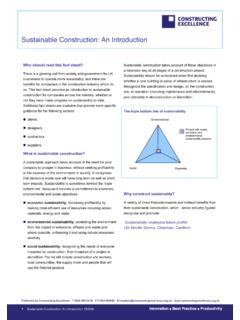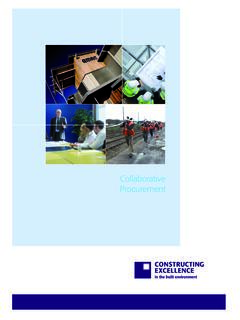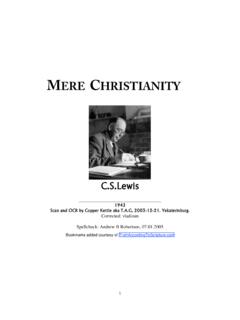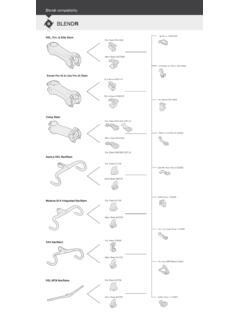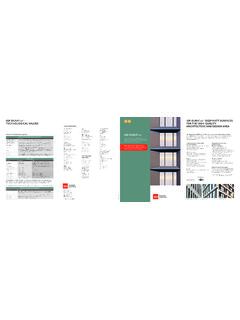Transcription of CONSTRUCTING
1 CONSTRUCTING THE TEAM by Sir Michael Latham Joint Review of Procurement and Contractual Arrangements in the United Kingdom Construction Industry Final Report July 1994 Crown copyright 1994 Applications for reproduction should be made to HMSO First published 1994 ISBN 0 11 752994 X Designed by Design, Drawing and Print Services DEPARTMENT OF THE ENVIRONMENT Foreword CONSTRUCTING the Team Executive Summary Chapter One Introduction and the Role of Clients Chapter Two General Comments on the Economic Background Chapter Three Project and Contract Strategies and Briefing Chapter Four The Design Process: Consultants and Specialist Contractors Chapter Five Contract Choice for Clients Chapter Six Selection/Tendering Procedures Chapter Seven Issues Which Determine Performance Chapter Eight Team Work on Site Chapter Nine Dispute Resolution Chapter Ten Insolvency and Security of Payment Chapter Eleven Liability Post Completion Chapter Twelve Implementation and Priorities Appendix I Appendix II TERMS OF REFERENCE FOR 'THE REVIEW THE FUNDING BODIES.
2 V .. vii .. 1 .. 7 .. 11 .. 23 .. 31 .. 43 .. 63 .. 81 .. 87 .. 93 .. 99 .. 107 .. 113 .. 114 Appendix 111 Appendix IV THE JCT AND THE CCSJC Appendix V NOTE BY THE CIC: AN ANALYSIS OF ACTION IN RELATION TO THE RECOMMENDATIONS OF THE CROSSING MEETINGS BOUNDARIES1 REPORT (At 15 April 1994) Appendix VI Construction Sourcing TEXT OF THE ClPS PROPOSAL FOR .. 116 .. 120 .. 123 .. 128 FOREWORD Last December, Trust and Money sought to identify the main issues of the Review, and invited comments and proposals. Avery large number have been received. Public debate has been encouraging, wide ranging and serious. This Final Report makes recommendations to tackle the problems revealed in the consultation process. The Review has been about helping clients to obtain the high quality projects to which they aspire. That requires better performance, but with fairness to all involved. Above all, it needs teamwork.
3 Management jargon calls that seeking win-win solutions . I prefer the immortal words of the Dodo in Alice s Adventures in Wonderland , Everybody has won and all must have prizes . The prize is enhanced performance in a healthier atmosphere. It will involve deeper satisfaction for clients. It will lead to a brighter image and better rewards for a great industry. The issues of the Review provoke profound disagreement throughout the construction process. I could not deal with every problem raised with me, still less seek to solve them all. Some proposals which were made to me towards the end of the Review require further debate. I have tried to produce a balanced package which offers hope to all, reassurance This has not been a Government Review of the industry. It has been a Report commissioned jointly by the Government and the industry, with the invaluable participation of clients: It has been completed within a very tight pre-determined timetable to discharge extremely wide terms of reference.
4 It is the personal Report of an independent, but friendly observer. No blame attaches to anyone except myself for its contents. I have been immensely helped by many people, and especially by Deborah Bronnert of the Department of the Environment, to whom I am particularly grateful. But shortcomings or mistakes in this Report are my fault alone. Some recommendations are radical. The participants in the construction process can react in three ways to them. to some, but despair to none. They can refuse to have anything to do with the Report. That would be a pity. The problems would remain, but the goodwill to tackle them, which has been growing dramatically over the last twelve months, would be lost. They can pick out the sections which suit them and reject the rest. If everyone does that, nothing will happen. Or, hopefully, they can try to make the package work, through the implementation structures which the Report recommends.
5 They can set about CONSTRUCTING the Team. The time to choose has arrived. The construction process cannot wait 30 years for another Banwell or 50 years for another Simon. Michael Latham July, 1994 v CONSTRUCTING the TeamExecutive reports on the construction industry have either been implementedImplementation begins with clients. The Department of the Environmentshould be designated by Ministers as lead Department for implementing anyrecommendations of the Report which Ministers accept. Government shouldcommit itself to being a best practice client. Private clients have a leading roleand should come together in a Construction Clients' Forum. Clients, andespecially Government, continue to have a role in promoting excellence indesign (Chapter 1, paragraphs ).The state of the wider economy remains crucial to the industry Many of theproblems described in the Interim Report, and also addressed in this FinalReport, are made more serious by economic difficulties.
6 But others are inherent(Chapter 2).Preparing the project and contract strategies and the brief requires patienceand practical advice. The CIC should issue a guide to briefing for clients(Chapter 3, paragraph ). The DOE should publish a simply wordedConstruction Strategy Code of Practice (Chapter 3, paragraphs - ) whichshould also deal with project management and tendering issues (Chapter 6).The process plant industry should be consulted by the DOE, and be part of theConstruction Clients' Forum (Chapter 3, paragraph ).A check list of design responsibilities should be prepared (Chapter 4, ).Use of Co-ordinated Project Information should be a contractual requirement(Chapter 4, paragraph ).Design responsibilities in building services engineering should be clearlydefined (Chapter 4, paragraph ).Endlessly refining existing conditions of contract will not solve adversarialproblems.
7 A set of basic principles is required on which modern contracts canbe based. A complete family of interlocking documents is also required. TheNew Engineering Contract (NEC) fulfils many of these principles andrequirements, but changes to it are desirable and the matrix is not yet clients wish, it would also be possible to amend the Standard JCT and ICEF orms to take account of the principles (Chapter 5, paragraphs - ).The structures of the JCT and the CCSJC need substantial change (Chapter 5,paragraphs - and Appendix IV).Public and private sector clients should begin to use the NEC, and phase out"bespoke" documents (Chapter 5, paragraph ). A target should be set of1/3 of Government funded projects started over the next 4 years to use theNEC.
8 Viiincompletely, or the problems have persisted. The opportunity which existsnow must not be missed (Chapter 1, paragraph ). should be a register of consultants kept by the DOE, for public sectorwork. Firms wishing to undertake public sector work should be on it (Chapter6, paragraph ).A DOE-led task force should endorse one of the several quality and priceassessment mechanisms already available for choosing consultants (Chapter6, paragraph ).The role and duties of Project Managers need clearer definition. Governmentproject sponsors should have sufficient expertise to fulfil their roles effectively(Chapter 6, paragraph ).A list of contractors and subcontractors seeking public sector work should bemaintained by the DOE. It should develop into a quality register of approvedfirms (Chapter 6, paragraph ). The proposed industry accreditation schemefor operatives should also be supported by the DOE (Chapter 7, ).
9 Tender list arrangements should be rationalised, and clear guidance issued(Chapter 6, paragraph ). Advice should also be issued on partneringarrangements (paragraph ).Tenders should be evaluated by clients on quality as well as price. The NJCC recommendations on periods allowed for tendering should be followed(Chapter 6, paragraph ).A joint Code of Practice for the Selection of Subcontractors should be drawnup which should include commitments to short tender lists, fair tenderingprocedures and teamwork on site (Chapter 6, paragraph ).Recent proposals relating to the work of the Construction Industry TrainingBoard (CITE) need urgent examination (Chapter 7, paragraphs - ).The industry should implement recommendations which it previouslyformulated to improve its public image. Equal opportunities in the industryalso require urgent attention (Chapter 7, paragraph ).The CIC is best suited to co-ordinate implementation of already publishedrecommendations on professional education (Chapter 7, paragraph ).
10 Existing research initiatives should be co-ordinated and should involve new research and information initiative should be launched, funded by alevy on insurance premia (Chapter 7, paragraph ).More evidence is needed of the specific effects of BS 5750 within the constructionprocess (Chapter 7, paragraph ).A productivity target of 30 per cent real cost reduction by the year 2000 shouldbe launched (Chapter 7, paragraph ).A Construction Contracts Bill should be introduced to give statutory backingto the newly amended Standard Forms, including the NEC. Some specificunfair contract clauses should be outlawed (Chapter 8, paragraphs - ).Adjudication should be the normal method of dispute resolution (Chapter 9,paragraph ). trust funds for payment should be established for construction workgoverned by formal conditions of contract. The British Eagle judgement shouldbe reversed (Chapter 10, paragraph ).The Construction Contracts Bill should implement the majorityrecommendations of the working party on construction liability law (Chapter"BUILD" insurance should become compulsory for new commercial, industrialand retail building work, subject to a de minimis provision (Chapter 11,improvements and encourage teamwork.))




